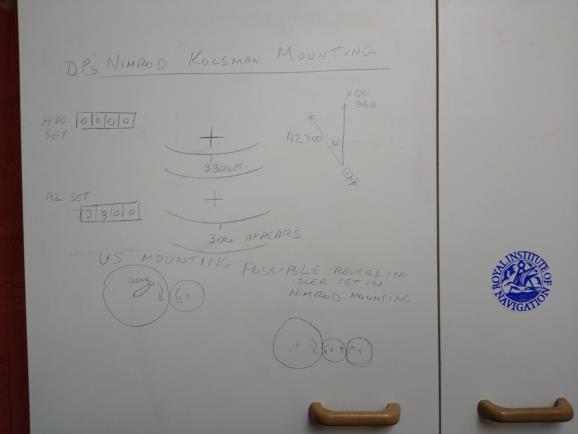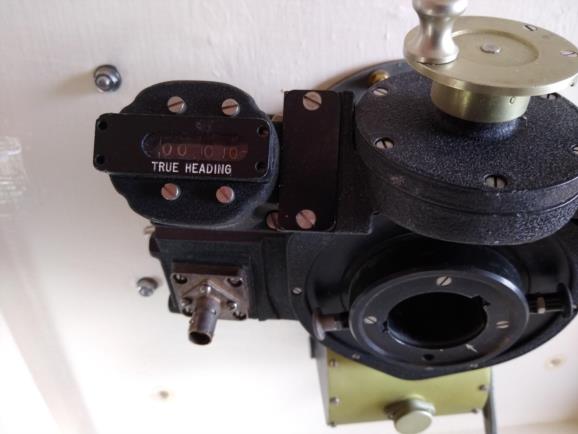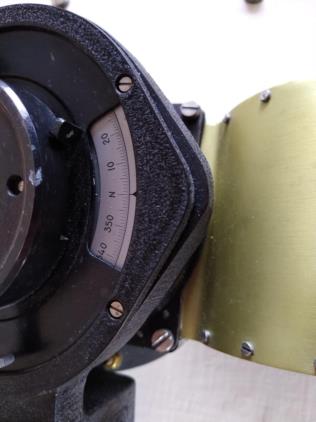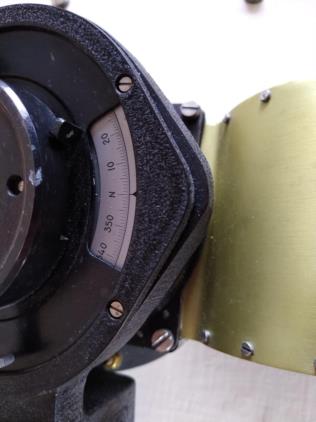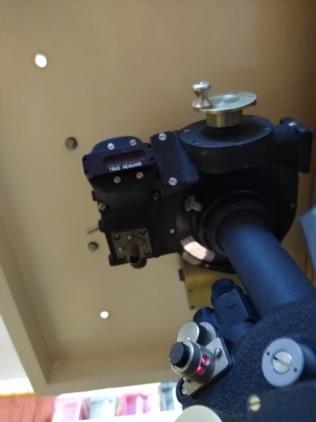
NavList:
A Community Devoted to the Preservation and Practice of Celestial Navigation and Other Methods of Traditional Wayfinding
From: David Pike
Date: 2022 Apr 19, 12:41 -0700
Ed
I can see I have accidentally misled you. When I drafted my answer to your question, I didn’t have access to my USAF ‘Flight Navigator Handbook’ which is on my PC. Instead, I used my own actual mounting, which I believe came from an RAF Nimrod aircraft. The Brits in their wisdom have specified my mounting to be marked and geared slightly differently. My azimuth counter window is marked ‘True Heading’ (see photo). I’ve rewritten my answer below for a USAF mounting. It doesn’t seem to matter whether you have Azimuth in the counter window and set heading though the eyepiece or the other way round, so long as you have the appropriate gearing (see photograph), you’re only setting up the difference between the heading and azimuth. Both ways seem to lead you to the star when used with the appropriate mounting. I could speculate why the RAF chose to do it their way, but perhaps some other time.
3. There’s only one rose/azimuth disc The ‘set azimuth crank’ is geared onto it. The figures you see through the eyepiece are of the same disc viewed through prisms though the lens in the top of the sextant (see photo). If you look at the bottom of the mounting, there’s a rotatable inner sextant holding sleeve with a 50-degree opening in it which shows a portion of the ‘azimuth disc’. If you rotate the sleeve with your fingers, you’ll find a ‘lubber line’ pointing towards the disc. If you wind the azimuth crank until 000.0 appears in the azimuth counter window on the mounting, the lubber line on the mounting will be pointing towards N on the azimuth disc (see photo).
4. If you can’t move the rotatable inner sleeve look at it and you’ll find a little lever next to the 50-degree disc viewing opening. You can use that lever to lock rotatable sleeve which holds the sextant to the azimuth disc by moving the lever clockwise. Then the only way you can move the sextant in its mounting is by turning the azimuth crank. Move that lever anti-clockwise to free the rotatable sleeve. Note also that the numbers on the azimuth disc increase anticlockwise to allow for the fact that in service the face of the disc points downwards. The mounting is also fitted to the aircraft such that if 000.0 is set in the azimuth counter window, N on the azimuth disc points towards the tail. This is to allow for the fact that the azimuth disc viewing window in the sextant is on the rear of the sextant while the index mirror window points forwards.
5. So, assuming your mounting is fitted in the aircraft correctly (i.e. With 180.0 set in the azimuth counter window, the centre of the fin corresponds with a heading under the sextant vertical cross hair of N) you find your star as follows. Set star’s azimuth in the azimuth counter window. Set Hc on the sextant. Swing the sextant until the aircraft heading appears on the azimuth disc under the vertical crosshair visible though the eyepiece. And there will be your star (plus 3 or 4 dimmer ones, but the pictures in the Air Almanac tell you which is yours).
6. To do a heading check. Set star’s azimuth in the azimuth counter window. Set approximate heading against the vertical cross hair in the eyepiece. Move the sextant until the star is over the vertical cross hair. Read your true heading under the vertical cross hair.
7. If this isn’t enough, I’ll go through your additional questions and assumptions, but I think the above covers most of it.
8. All I do with the Astro Van with my Nimrod mounting is wait for a sunny day. Set Hc on the sextant and find the Sun. Crank the winder until the Sun’s azimuth also appears in the eyepiece in line with the cross hairs. The value on the counters is my Astrovan pseudo-heading (i.e. I’ve no idea how the mounting’s lined up in the van, but it’s fixed in that position). Then I continue to use that pseudo-heading on the counters until next time I move the Astrovan).
9. The value of a set the heading on the counters mounting like mine is that for a three-star fix, you can swing the sextant around between stars easily without turning the crank to a new azimuth for each star. Much easier just to swing and look for azimuth through the eyepiece. DaveP
